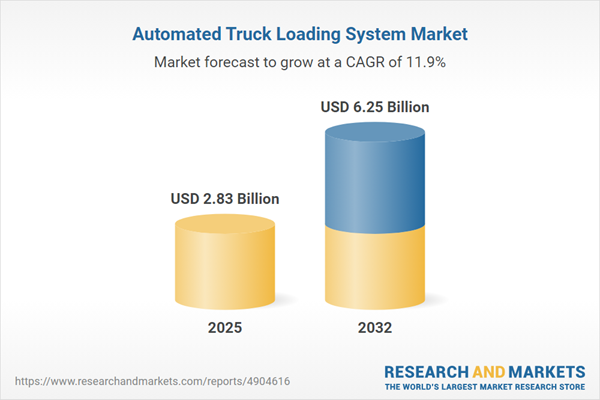Speak directly to the analyst to clarify any post sales queries you may have.
Automated truck loading systems are reshaping logistics management for senior executives, delivering improved process efficiency, operational scalability, and end-to-end supply chain visibility. As automated solutions become central to logistics strategies, organizations are leveraging these systems to boost resilience and maintain a competitive edge in a rapidly changing industry landscape.
Market Snapshot: Automated Truck Loading System Market
The market for automated truck loading systems is experiencing global growth as organizations invest in logistics automation to overcome pressing operational challenges. In 2024, the market value is USD 2.53 billion, projected to rise to USD 2.83 billion by 2025, at a compound annual growth rate (CAGR) of 11.93%. Long-term forecasts indicate the market could reach USD 6.25 billion by 2032.
This expansion reflects increasing focus among logistics leaders on utilizing automation for more complex freight operations, rapid response to supply chain shifts, and changing customer expectations. The current environment drives ongoing investment in advanced technologies to support business agility, differentiate strategically, and align with global digital transformation and regulatory developments.Scope & Segmentation of the Automated Truck Loading System Market
This report provides actionable insights for senior leaders on the automated truck loading system market, with detailed segmentation by operational requirements, deployment scenarios, and sector applications:
- Vehicle Types: Solutions are engineered for container trucks, rigid trucks, and tractor trailers, addressing a range of transportation needs across shipping operations.
- Payload Capacity: Platforms are designed for below 10 tons, 10 to 20 tons, and over 20 tons, providing scalable deployments and supporting diverse freight volumes in dynamic logistics environments.
- Automation Level: Organizations can select from fully automated, semi-automated, and manual-assisted systems, allowing phased integration aligned with risk tolerance and digital maturity.
- Installation Type: Stationary and portable implementations offer flexibility for both new and existing warehouses, adapting to facility layouts and evolving operational demands.
- Applications: Automated truck loading systems are utilized in automotive, chemicals, e-commerce, B2B and B2C retail, and food logistics (including bakery, dairy, and meat), supporting process reliability and compliance in regulated environments.
- Regional Coverage: Strategies for adoption differ across America, Europe, Middle East & Africa, and Asia-Pacific, influenced by infrastructure maturity, regulatory factors, and technology readiness unique to each region.
- Highlighted Companies: Key market participants include Blue Star Engineering & Electronics Ltd., Alligator Automations, Joloda Hydraroll Limited, Wipro Enterprises (P) Ltd., Atmos Systems, Bastian Solutions LLC, Europa Systems sp. z o.o., WDX Inc., Damon Australia, and Integrated Systems Design, each driving industry innovation and expanding solution availability.
Key Takeaways for Senior Decision-Makers
- Automation solutions enable organizations to enhance supply chain continuity and quickly adjust to market disruptions or shifting demands, minimizing risk to logistics operations.
- Continuous innovations in robotics and smart control systems contribute to improved precision in cargo handling, reinforcing safety standards and compliance with global regulations.
- Scalable and modular technologies support seamless expansion, facilitating operational transitions and reducing exposure during process upgrades or facility redesigns.
- Procurement decisions are increasingly guided by organizational priorities for sustainability, with a focus on efficiency and environmental criteria when selecting new systems.
- Wide supplier capabilities allow tailored automation solutions to address sector-specific needs, providing flexibility for businesses as requirements evolve.
- Organizations must align deployment with local digital infrastructure and regulatory context, optimizing supplier choice and risk management strategy in each region.
Tariff Impact on Automated Truck Loading System Components
Shifts in U.S. tariff policy are affecting cost structures for components such as steel and electronics. To reduce impact, suppliers are diversifying their sourcing networks and forming regional supply partnerships. Procurement teams are also revising sourcing strategies to manage compliance and operational risk in light of new trade regulations.
Methodology & Data Sources
Market analysis is grounded in in-depth primary interviews with logistics practitioners and technical experts, supported by input from sector professionals. Findings are validated through analysis of company documents, financial statements, and industry-leading publications to ensure reliable and nuanced insights.
Why This Report Matters
- Empowers logistics leaders to make informed decisions on automation investments, ensuring resources are allocated for sustainable process improvements.
- Delivers frameworks for risk management and performance benchmarking in response to evolving logistics, compliance, and procurement challenges.
- Supports practical integration of automation technologies, enhancing alignment with best practices in procurement and regulatory compliance.
Conclusion
This report provides senior decision-makers with the insights needed to advance automated truck loading initiatives, strengthening supply chain capabilities and supporting forward-looking logistics planning across varied operational contexts.
Additional Product Information:
- Purchase of this report includes 1 year online access with quarterly updates.
- This report can be updated on request. Please contact our Customer Experience team using the Ask a Question widget on our website.
Table of Contents
3. Executive Summary
4. Market Overview
7. Cumulative Impact of Artificial Intelligence 2025
List of Figures
Companies Mentioned
The companies profiled in this Automated Truck Loading System market report include:- Blue Star Engineering & Electronics Ltd.
- Alligator Automations
- Joloda Hydraroll Limited
- Wipro Enterprises (P) Ltd.
- Atmos Systems
- Bastian Solutions, LLC
- Europa Systems sp. z o.o.
- WDX Inc.
- Damon Australia
- Integrated Systems Design
Table Information
| Report Attribute | Details |
|---|---|
| No. of Pages | 191 |
| Published | November 2025 |
| Forecast Period | 2025 - 2032 |
| Estimated Market Value ( USD | $ 2.83 Billion |
| Forecasted Market Value ( USD | $ 6.25 Billion |
| Compound Annual Growth Rate | 11.9% |
| Regions Covered | Global |
| No. of Companies Mentioned | 11 |









